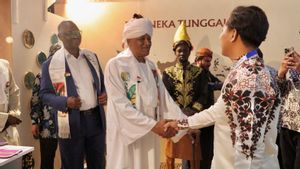YOGYAKARTA - In the midst of modernity and upholding human rights, a controversial practice still overshadows several regions in Indonesia, namely Kawin Capture. Why is this practice still happening? Let's get to know the tradition of close arrest marriage.
This article will further investigate the intricacies of the Kawin Capture tradition, highlight its cultural roots, the motive why it is still happening in society, and its impact on women.
On Sumba Island, especially in Southwest Sumba Regency, in addition to the common practice of marriage known in general, there is also the tradition of catching marriage or paneta mawinne.
This procession is a form of marriage that takes place without the consent of one party, namely the woman. Unlike marriages based on love, arrest marriages occur based on agreements between male and female families, often without the knowledge of the prospective bride and groom.
Reporting from the Journal of Equality, Volume 3 of 2021, various motivations are motivated by the practice of arrest marriage, including economic considerations and influence. In the economic context, women are often used as ransom to pay off debts.
In addition, the reason for maintaining or strengthening kinship relations between the two obstetrics (suku) is also a driving force for this practice.
Also read cultural articles discussing Carok History: The Political Tool Of The Dutch Colonial Team In Madura
The tactics commonly used in catching marriages are by waiting for women in public places such as markets. There, several men had prepared to catch or divorce him, then forcibly carry him on a horse to his future husband's residence.
Because without prior approval, this situation often surprised women and shouted for help.
Arriving at the arrival of the female victim of the kidnapping at the house of her future partner, an ongoing process occurred, namely the arrival of a female family to find their child.
The arrival of the family was not without intent, but part of the planned tactics. The success of this tactic was followed by discussions on the schedule of traditional marriages and the amount of belief to be given.
In the context of Kawin Capture marriage, women are often in a position of surrender, following the wishes of their parents and extended family.
The phenomenon of catching marriage can be categorized into two types based on the consent of women.
First, the practice carried out on the basis of an agreement between prospective brides and grooms, as well as the blessing of the two extended families.
In this scenario, women will be dressed and equipped with household appliances at the specified location, signaling their readiness to be "arrested" as part of the marriage process that makes it easier to give dowries.
Second, the practice of catching marriage that occurs without consent or based on feelings of love from women. This action involved forced kidnapping of women in public places such as markets by a group of people with the aim of making her a wife.
SEE ALSO:
Interestingly, the motives and backgrounds of this practice vary, ranging from debt repayment, strengthening kinship relations, to fulfilling parents' promises. This makes the background of catching marriages wider.
Apart from knowing the tradition of catching marriage, follow other interesting articles too. Want to know other interesting information? Don't miss it, keep an eye on the updated news from VOI and follow all of its social media accounts!
The English, Chinese, Japanese, Arabic, and French versions are automatically generated by the AI. So there may still be inaccuracies in translating, please always see Indonesian as our main language. (system supported by DigitalSiber.id)
















